Contents
Not all site owners have the time and desire to understand the types and varieties of plants. Many simply want to have a beautiful garden, plant yellow roses here, columnar juniper there. But flipping through literature or carefully studying articles on the Internet in order to first choose the type of conifer, and then read the description of the varieties, is not possible.
A selection that tells very briefly about which columnar junipers can be planted in the garden will also be useful for “advanced” lovers. It will help save time when choosing plants. Of course, it is impossible to give all varieties of junipers with a narrow crown in one article, the published information will only give the right direction when searching for crops.
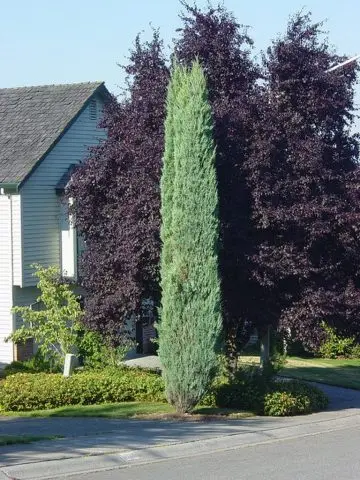
Description of juniper columnar
The genus Juniperus (Juniperus) belongs to the Cypress family, it includes about 75 species distributed in the Northern Hemisphere from Alaska to Africa. Some of them are columnar in shape.
At the same time, the species juniper does not always have a narrow ascending crown. It can be of any configuration, only upright varieties have not yet been bred from creeping forms. But on junipers with a columnar or pyramidal crown, mutations were found, from which various cultivars were created.
That is why, within the same species, you can find varieties with an upright, rounded, weeping and creeping shape. Often it is difficult not only to attribute them to one taxon, but even to suspect them of being related.
Why does the juniper look different from the picture
Not only beginners, but also many experienced gardeners consider it the height of snobbery when someone orders a common juniper variety in a certain foreign nursery. After all, it can be bought much cheaper from local manufacturers! Yes, and such a plant will take root faster and better.
And varieties propagate, for the most part, cuttings. They are nothing but a clone of the same plant. And they should look like twins. But it is not so. Or rather, not at all. That is why junipers of the same species and variety can be very different.
The question needs clarification. Juniper is a plastic culture. This explains the variety of varieties. Mutations constantly occur in nature, soil, water, environmental conditions, climate, the presence or absence of top dressings affect the appearance of the plant. The list is endless. Many believe that even the fact that the owners of the juniper and each other love each other, whether they are evil or good people, is of great importance.
So everything is changing. Plants too. They grew a juniper from a sprig, took it to another country, or simply placed it in excellent conditions. When cuttings, his “children” will already be slightly different. And so on. Or maybe the differences will be so significant that a new cultivar will appear!
And since nurseries are constantly culling seedlings for varietal inconsistency, the junipers in them really resemble each other, like twins. But they may well differ from those grown by another organization. But everything will be within the “limits” of the grade!

What do columnar junipers of different species and varieties have in common
Whatever the type of columnar junipers, they all have a slender, elongated crown. It can be tall and low shrubs or trees.
The branches of narrow-columnar junipers are directed vertically and tightly pressed against each other. They resemble a pillar and are clearly visible from all sides.
In broadly columnar junipers, the crown is somewhat wider, and the shoots are more loosely arranged. They do not always look like an obelisk, they can be spindle-shaped.
The prickly or soft needles of the columnar juniper depend on the species, the color of the needles is determined by the variety.
Types and varieties of juniper columnar
There are so many varieties of junipers with a columnar crown that it is impossible to list them all. In addition, the creation of new cultivars does not stop. Species often used in culture on the territory of Our Country, Europe, neighboring countries are proposed for consideration.
Columnar Juniper virginiana
The species has given rise to many columnar cultivars. It is a tree with a fairly thick trunk. The needles are often needle-shaped, prickly, but in older plants it can be partially scaly. Coloration ranges from green to grey.
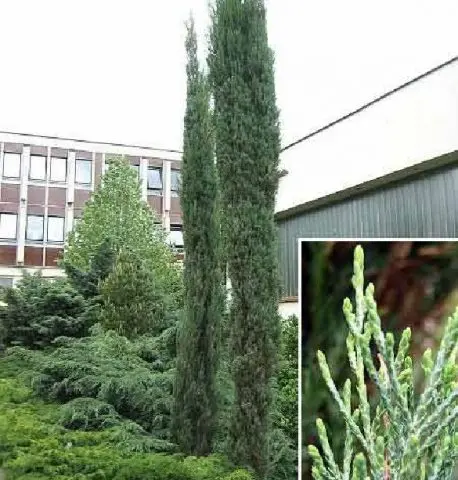
Lives for over 100 years. In the middle lane winters without shelter. It tolerates urban conditions well, and can grow even on moderately saline lands and construction debris sprinkled with soil.
Among the columnar varieties of Juniperus virginiana stand out:
- Boskop Purple (Boskop Purple) with gray-blue needles;
- Canaertii (Canaertii) with dark green needles – the crown, depending on the nursery, can be columnar or cone-shaped;
- Robusta green (Robusta green) – green-blue needles;
- Fastigiata (Fastigiata) – columnar juniper with blue needles;
- Skyrocket forms a narrow tree with silvery needles;
- Glauca (Glauca) – blue with a wide-columnar crown;
- Burki (Burkii) – the shape of the crown becomes straight and even only in an adult tree;
- Spartan (Spartan) with a wide-columnar crown and green needles.
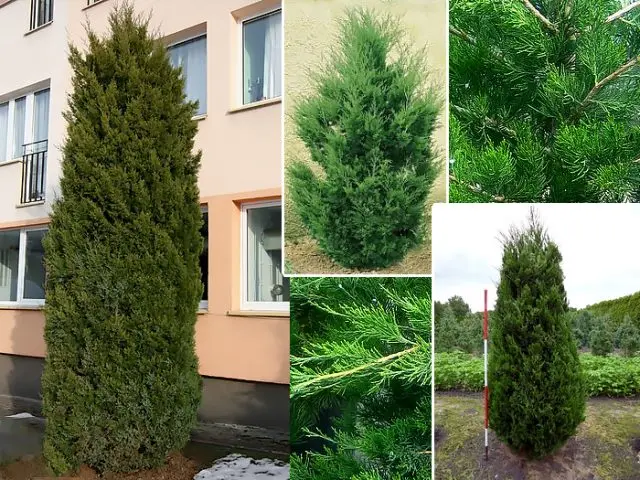
Columnar Juniper
This is what kind of crown can actually look like a pole, without any discounts! The needles of this columnar juniper are prickly, sharp, but not too hard. It is the cones of plants of this species that are added to gin.

There are many varieties with a narrow crown, it is worth mentioning separately:
- Meyer (Meyer) with a symmetrical, rather wide crown, and blue-green needles;
- Suecica, which has several forms, including those with golden needles;
- Sentinel (Sentinel) with a narrow cigar-shaped crown, green needles, acquiring a bluish tint by the end of the season;
- Gold Cone – wide cone with golden needles;
- Compress (Compressa) – undersized columnar juniper;
- Hibernica (Hibernica) with a narrow dense crown and bluish needles;
- Arnold (Arnold) – columnar with green, sometimes bluish needles;
- Erecta (Erecta) is similar to Hibernica, but with a narrower crown.
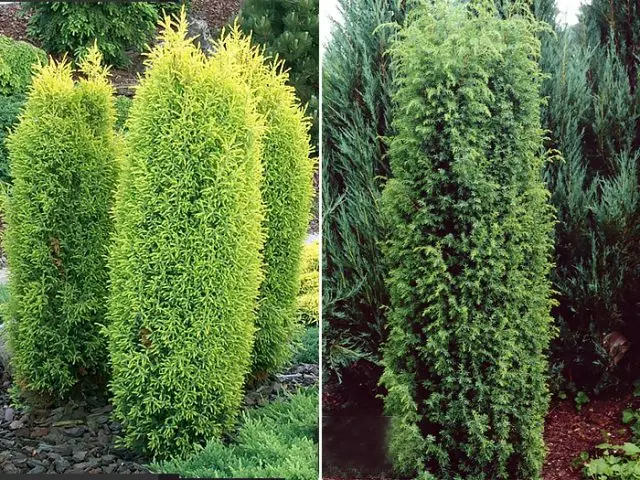
Columnar Juniper Rocky
The species includes trees, often multi-stemmed, with thick tetrahedral shoots and dark red-brown bark. The needles are scaly, usually gray, but sometimes green. The most drought-resistant species, gave many columnar forms. Among them:
- Blue Arrow (Blue Arrow) – one of the most famous, with a narrow crown and silver needles;
- Blue Angel (Blue Angel) – columnar with bluish-gray needles;
- Gray Clem (Gray Cleam) has a beautiful symmetrical crown and silver-gray needles;
- Silver Cord – a variety of columnar juniper for a small garden with a thin crown, bluish-silver needles;
- Skyrocket – Blue Rocket, the most famous variety, nowhere without it;
- Springbank (Springbank) – a narrow crown with slightly bent tips of the shoots and bright silvery needles.
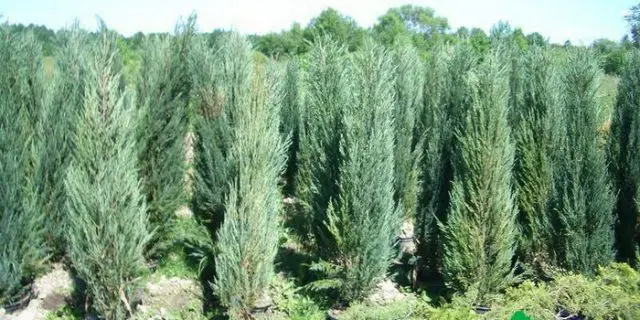
Columnar Chinese Juniper
This species is interesting in that both needle and scaly needles grow on adult specimens, and male and female plants are very different.
It should be highlighted:
- Columnaris (Columnaris) – columnar, with branches loosely adjacent to each other, but directed upwards;
- Mountbatten (Mountbbatten) is shaped like a wide cylinder, with short branches, gray-green needle needles;
- Obelisk (Obelisk) – the famous low juniper with a wide columnar crown and prickly needles;
- Stricta is a common variety with raised branches, a dense crown and sharp bluish-green needles that change color to yellowish-gray in winter.
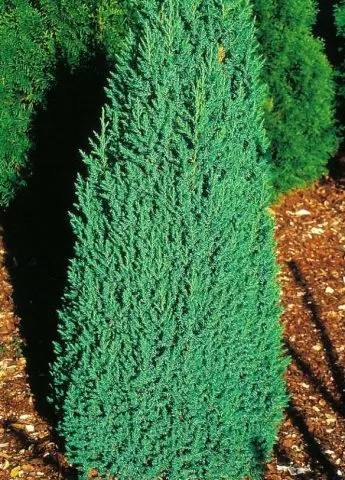
Features of growing columnar juniper
Indeed, when caring for a juniper with a columnar crown, some features must be taken into account. It is a branched tree with one, often several trunks or a shrub. The shoots are raised up and form a dense crown.
In all columnar junipers, they are more or less pressed against each other, so the crown is poorly ventilated, little light gets inside. As a result, the needles near the trunk quickly dry out. When carrying out sanitary measures, it is necessary not only to remove dead and broken branches, but also to clean off the needles. Otherwise, a spider mite will settle there, which is especially difficult to fight on plants with sharp needles.
Pest and disease control is another feature that you need to be aware of when caring for columnar juniper. You need to constantly monitor him, since all the “problems” can hide inside a dense crown. Shoots are regularly inspected, especially those that grow without access to light.
Sprinkling is useful for junipers, columnar varieties are no exception. That’s just watering species with sharp needles from a hose is better in the early morning, and not in the evening. Needles do not always have time to dry before nightfall, moisture lingers in the sinuses of the vegetative organs. Because of this, various rots appear, and in warm regions (not necessarily southern ones), a difficult-to-breed mealybug also appears.
Planting and caring for columnar juniper
In a juniper, a columnar planting is no different from varieties with a different crown shape. A pit is dug so deep that a root and drainage can fit in it, the diameter is 1,5-2 times greater than an earthen clod. The root neck is at ground level. Soddy soil, peat, sand are added to the substrate for planting.
The only difference is that for a seedling exceeding a height of 50 cm, a peg is driven into the bottom of the pit, to which a juniper is tied. This is done just for stability.
Water abundantly only after planting. Then – depending on the recommendations, usually – moderately. The most undemanding to watering is Rocky Juniper.
The greatest differences in columnar varieties from those with a crown of a different shape are in shelter for the winter. Its branches must be tied with twine, otherwise the snow can simply break the plant.
Soil mulching for columnar forms is also a mandatory procedure. Their root is not protected by branches lying on the ground. Covering material protects it from freezing in winter, and prevents it from overheating in summer.
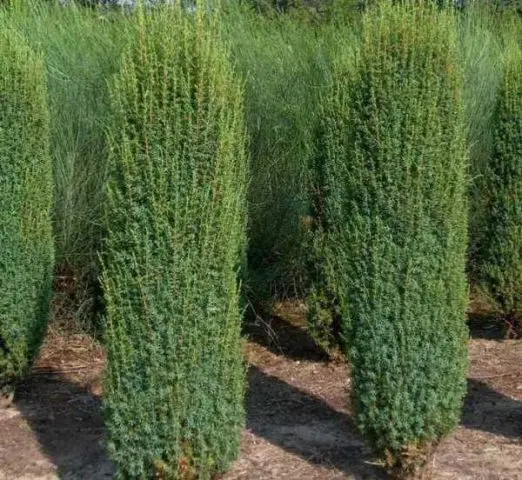
Pruning juniper columnar
In fact, the culture perfectly tolerates pruning, regardless of the shape of the crown. Columnar junipers with a haircut can be given a more rigorous shape. It is from them that topiary is made. For primary trimming, you should invite a specialist, then maintain the shape yourself.
For all columnar forms, an important element of care is sanitary pruning. In addition to the fact that dry and broken branches are clearly visible on a narrow crown and look unattractive, the health of the juniper also depends on this. Pests quickly start up on dry shoots and fungal spores settle. And since the branches are pressed against each other, any “trouble” will quickly spread throughout the plant.
How to propagate columnar juniper
Shoots take root all season. But for lovers who have never been involved in the propagation of coniferous crops, it is better to take them in the spring, tearing them off along with the “heel”. The lower part is freed from needles, treated with a stimulant, planted in sand, perlite or pure peat.
Rooting takes 30-45 days. After that, the cuttings are transplanted into individual containers. They should not be overexposed in a light substrate – juniper needs nutrition for growth, and perlite or sand cannot give it.
From the moment of grafting to planting in the ground, at least two years should pass.
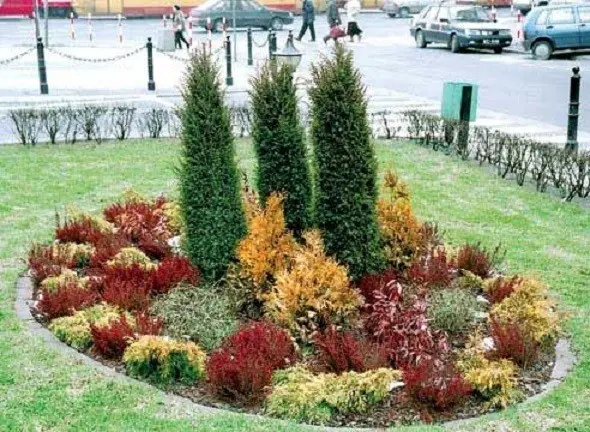
Conclusion
Columnar juniper is a good solution for any garden. It looks attractive, takes up little space, and requires minimal maintenance. In addition, if desired, you can create a topiary from it.









